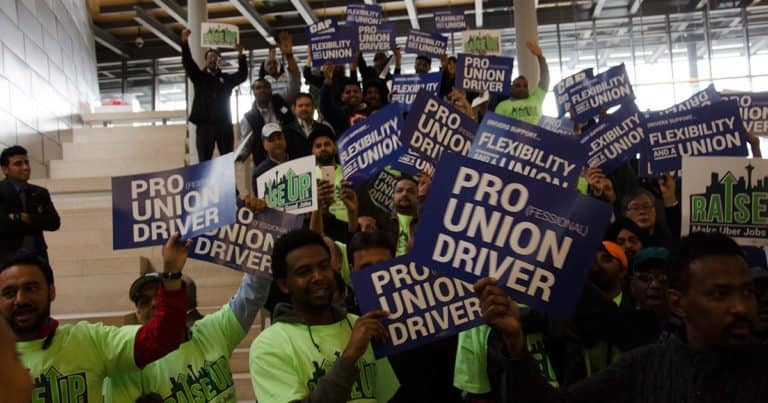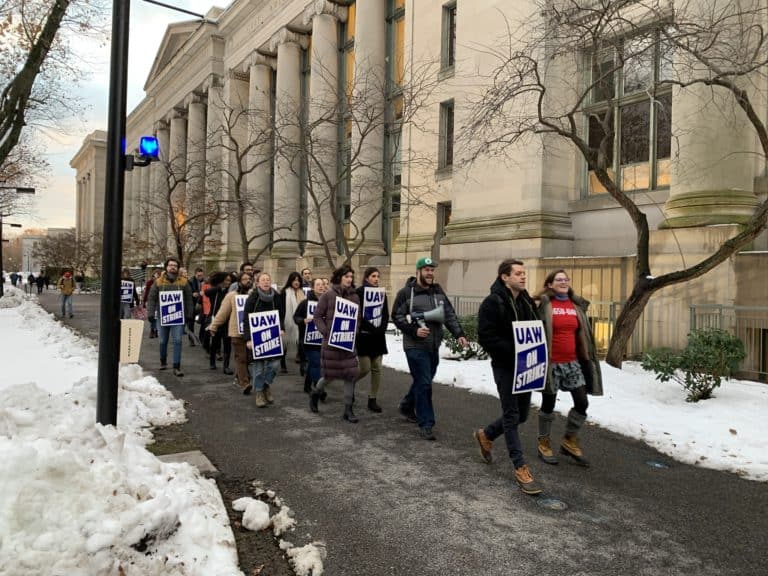
Brishen Rogers is an Associate Professor of Law at Temple University, a Visiting Professor at Georgetown University Law Center (Fall 2019), and a Fellow at the Roosevelt Institute.
I appreciate Andy Stern’s response to my recent post on labor law reform and UBI. I think we agree on almost everything, but disagree in a couple important respects.
Let me first trace the large zone of agreement. I think we’re both committed to an egalitarian social democracy, by which I mean a capitalist society in which a strong state ensures political, economic, and social equality. We also agree on some key economic reforms, such as enhancing workers’ bargaining power through higher minimum wages and unions where possible, protecting and expanding social insurance programs, and ensuring basic economic security by making access to basic resources a matter of right.
And I strongly agree with Stern that “UBI and labor law reform are two distinct ideas, and are neither mutually exclusive nor inclusive.” The notion that a UBI would render wage/hour and collective bargaining laws less necessary is a frustrating trope in the literature, as I argued in a recent Boston Review forum. Social democratic parties have long pursued both structural market reforms and more generous welfare benefits.
But of course many UBI proponents aren’t social democrats or even egalitarians. Sam Altman of Silicon Valley accelerator Y Combinator, who is funding policy work around UBI, has argued that once everyone’s basic needs are met, people should be free to “get as rich as they f***ing want.” Charles Murray would use UBI to replace the welfare state. This makes a progressive-libertarian alliance less promising, a point Connie Razza explores, based on her own organizing experiences, in that same Boston Review forum. We can have a small state, or we can have equality, but we can’t have both.
Why? As Ben Sachs aptly put it, I think a progressive UBI would represent “a fairly fundamental reordering of our political economy.” It would “Raise the Floor,” in Stern’s words: giving $12,000 to each citizen each year would dramatically reduce poverty and give citizens more power over their daily lives. But it would also lower the ceiling, reducing the income and wealth of the top 1%, 5%, and likely 20%. This latter point is critical for a few reasons: the program of course needs to be funded; reducing top income and wealth shares is morally appropriate; and doing so would alter the top bracket’s preferences and behavior in socially beneficial ways that I explored in my earlier post.
Stern and I diverge on what this all means for political strategy. Stern points to the remarkable success of marriage equality and the ACA, and suggests a “big leap, quick-change approach” of rapid institutional change. He is of course correct that major political reforms require unusual alliances, and often happen quickly. But I’m not convinced that a progressive UBI could follow that model today.
In the past, “big leap” progressive political-economic reforms have often followed major social conflict. The core of the New Deal labor policy – the NLRA, FLSA, and the Social Security Act – were all passed against the backdrop of decades of labor violence, the Great Depression, and the rise of communism and fascism. The Reconstruction Amendments were passed in the wake of the Civil War. Title VII was passed amid violent conflicts between civil rights protesters and Southern leaders. Looking to Europe, the British National Health Service and many elements of the French welfare state were created during the humanitarian crises that followed World War II.
Indeed, Walter Scheidel has recently argued that throughout history the most effective means of equalizing wealth have been to seize it (in civil unrest), to destroy it (in war), or to render it valueless (though economic or social collapse). War and global warming or pandemic aside, the most likely candidate today seems to be a massive displacement of workers by robots and artificial intelligence, which helps explain Silicon Valley’s enthusiasm for UBI. I’m skeptical that automation is a major threat today, but that’s beside the point for now. If we face a crisis of that magnitude – which, to be clear, neither I nor Stern nor anybody else sensible wants – all political bets are off.
So rather than trying to pass whatever can be passed in the short term, with whatever allies can be found, I think the better strategy is to create a new political reality over the long term. The intermediate steps could surely include passing a less generous UBI (or “base income”), so long as doing so does not require major benefit cuts in other areas. Stern and I may well converge on that point.
But we’ll ultimately need to lower the ceiling if we’re going to raise the floor, and unless we have enormous productivity growth, that will require a combination of income compression through worker empowerment, and new taxes that reduce top income and wealth shares. A carbon tax is a great idea for many reasons, but it can actually hit poorer families harder than richer ones, as can a VAT. A Tobin Tax and asset tax would be much more progressive, but that makes them extremely difficult to pass and maintain, not to mention anathema to many libertarians.
So I think we need to build, as Sachs put it, “the political conditions necessary to support a progressive UBI.” Those include progressive taxes funding public goods that citizens want and need, new forms of worker representation, and other new citizen organizations. Many of the policies required – higher minimum wages, better education and transit, and Medicare expansion – enjoy surprising support across racial, religious, regional, and party lines. Trying to unite those groups into a modern social democratic movement is not a “loser mentality,” but a realistic long-term strategy.









Daily News & Commentary
Start your day with our roundup of the latest labor developments. See all
November 28
Lawsuit against EEOC for failure to investigate disparate-impact claims dismissed; DHS to end TPS for Haiti; Appeal of Cemex decision in Ninth Circuit may soon resume
November 27
Amazon wins preliminary injunction against New York’s private sector bargaining law; ALJs resume decisions; and the CFPB intends to make unilateral changes without bargaining.
November 26
In today’s news and commentary, NLRB lawyers urge the 3rd Circuit to follow recent district court cases that declined to enjoin Board proceedings; the percentage of unemployed Americans with a college degree reaches its highest level since tracking began in 1992; and a member of the House proposes a bill that would require secret ballot […]
November 25
In today’s news and commentary, OSHA fines Taylor Foods, Santa Fe raises their living wage, and a date is set for a Senate committee to consider Trump’s NLRB nominee. OSHA has issued an approximately $1.1 million dollar fine to Taylor Farms New Jersey, a subsidiary of Taylor Fresh Foods, after identifying repeated and serious safety […]
November 24
Labor leaders criticize tariffs; White House cancels jobs report; and student organizers launch chaperone program for noncitizens.
November 23
Workers at the Southeastern Pennsylvania Transportation Authority vote to authorize a strike; Washington State legislators consider a bill empowering public employees to bargain over workplace AI implementation; and University of California workers engage in a two-day strike.